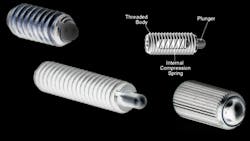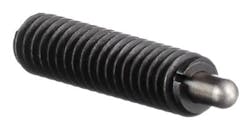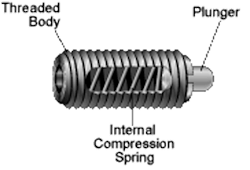Spring-loaded plungers use a spring and a plunger (or ball tip) to exert a precise and repeatable force. They are a better option than having engineers cobble together an assembly that uses a simple, standard spring and plunger nose to do that same task. For example, plungers are easier to install and offer a single assembly that replaces several components. Plungers also streamline the process of setting up manufacturing lines and tooling.
The spring keeps constant pressure on the plunger when it is in the resting position. In the resting position, or full travel position, the plunger is extended. It can be pushed back into the body of the device when force on the plunger exceeds the spring force being applied. If that force is not directly in line with the plunger, it is a side load. Strong-enough side loads will force the plungers on devices equipped with rounded noses to retract. Side loadings are used to activate spring-loaded devices in indexing, positioning and detenting operations.
When the force on the plunger is reduced, the spring extends the plunger once again. This is termed a cycle. Spring-loaded plungers can handle from one to several thousand cycles. Cycle life depends on the design of the plunger and the environment.
Spring-load plungers operate in any orientation; “up” and “down” have no bearing on plunger function. For example, they are routinely used in commercial and military aircraft.
Spring-loaded devices are commonly used in applications that require positioning and securing, indexing, locating, quick disconnects and ejecting, positive locking, latching and more. They fall into four main categories: standard spring plungers, stubby plungers, ball plungers and push-fit/press-fit plungers. Each provides different benefits.
Standard spring plungers offer long travel and several material and design options, including a range of plunger nose designs and spring-force options. The larger ones, however, might not fit in tight spaces.
Stubby plungers are more compact, making them a good choice for applications with limited space. There are a range of spring-force and plunger-nose travel options. But their small size limits the spring force they can exert.
Ball plungers are commonly used for notching and indexing where they are released with predetermined side loads. These side loads are generated by the shape of the detent coupled with the spring force. They can be designed to exert a specific level of force and apply it in detenting, indexing or locating operations. Ball plungers often require a slot or hex head screwdriver for installation.
Push-fit/press-fit plungers are well-suited when threaded ball plungers are impractical due to space restrictions. Push-fits can be manually installed easily and feature a flanged body to ensure consistent force delivery. Press-fit plungers can be quickly installed using a press, and offer a secure but permanent fit. Vlier’s push-fit/press-fit plungers come with a plunger or ball nose and provide a quick, efficient installation process that saves time and cost.
Engineers and designers trying to get the best plunger for their application should consider:
End force. Spring-loaded plungers can exert forces ranging 0.125 to 68 lb, depending on their size.
Travel. The delivered force is affected by the mechanism’s travel (range or motion), with the force increasing as the spring is compressed.
Thread size. Plungers come in a variety of thread sizes to fit most applications. Manufacturers usually put a table of available sizes in their catalogs.
Style. Plungers can be installed using threads and push-fit or press-fit designs. Engineers can choose the style that best meets installation requirements and client preferences.
Due to their versatility, spring-loaded plungers are commonly found in a host of industries, including defense, aerospace and automotive. A few examples include:
Defense. Standard spring plungers are used as a detent pin for fuel injection and weapon subsystems.
Aerospace. Standard spring plungers are often used on cabin interiors. Stubby plungers are used to stabilize, position and secure seat backs and tray tables on airliners.
Automotive. Phenolic and Delrin nose plungers are used in drivetrains and steering components, as well as seat positioners.
Spring-loaded plungers aren’t always the right choice. In applications that are less complex or require less precision, for example, they can be expensive overkill. And, as previously stated, space restrictions can favor one type of plunger over another.
Leading manufacturers of spring-loaded plungers continue to explore new materials and designs that lend themselves to new manufacturing processes and creating parts for different industries, including IIoT. Spring-loaded devices will continue to help companies bring products to market faster and with more reliable performance and added functions.
Thomas Foley is general manager at Vlier Inc., a company that makes mechanical components such as spring plungers, quick releases and leveling devices found in aerospace platforms, credit card readers, medical instruments, rollercoasters and high-speed rail.




